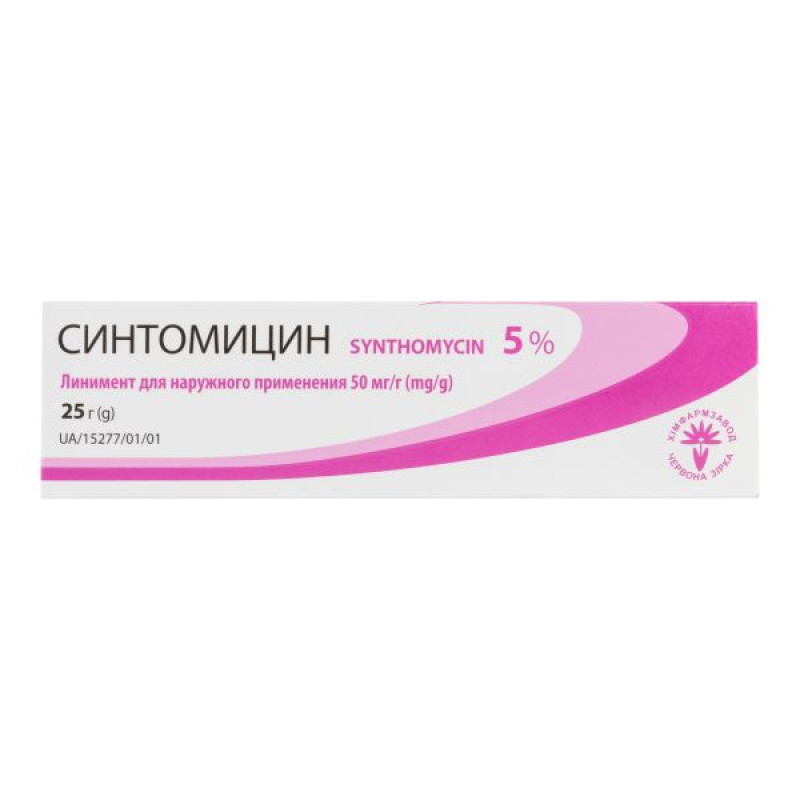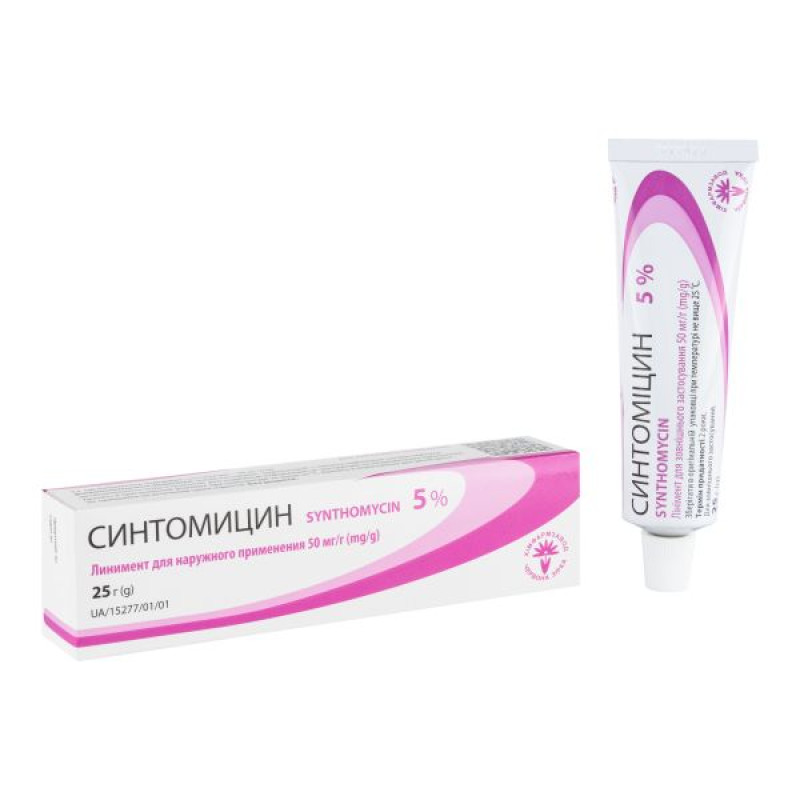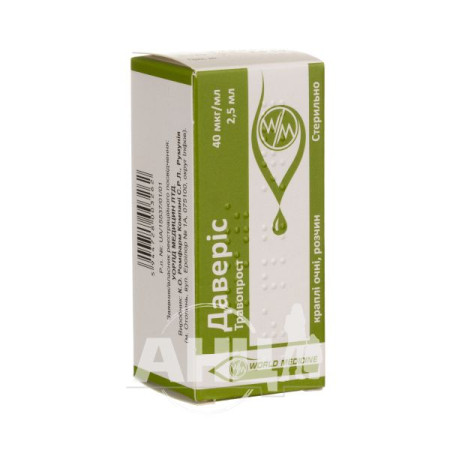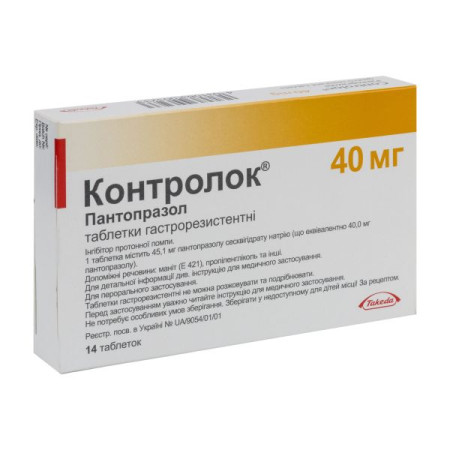Synthomycin liniment for external use 5% tube 25 g
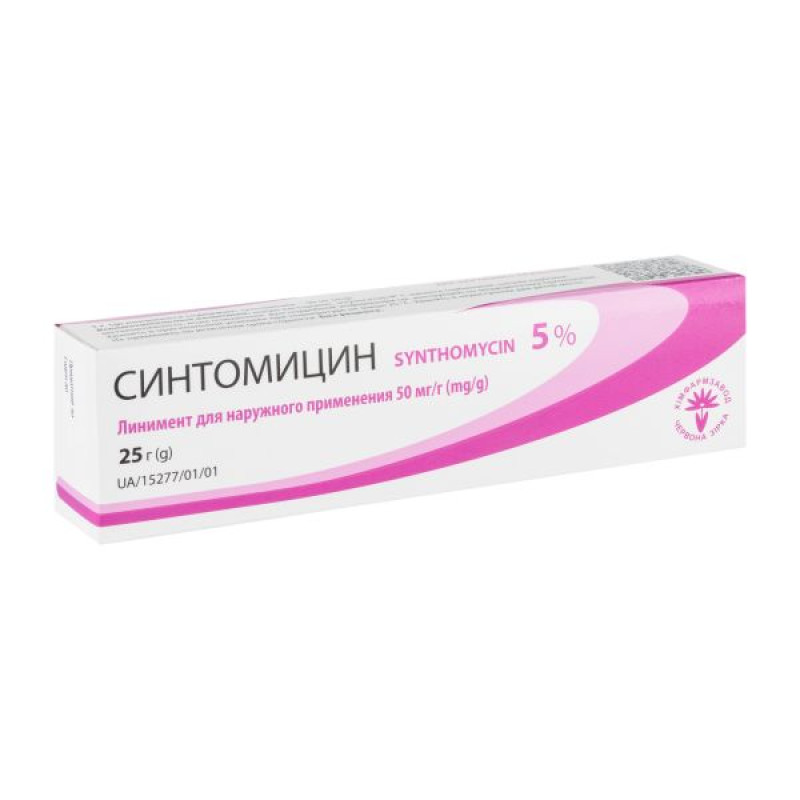
Instructions for Synthomycin liniment for external use 5% tube 25 g
Composition
active ingredient: 1 g of liniment contains synthomycin 50 mg or 100 mg;
excipients: castor oil, emulsifier No. 1, sorbic acid, sodium carboxymethylcellulose, purified water.
Dosage form
Liniment for external use.
Main physicochemical properties:
Liniment white or white with a yellowish tinge, with a faint specific odor.
Pharmacotherapeutic group
Antibiotics for topical use.
ATX code D06AX02.
Pharmacological properties
Pharmacodynamics.
Broad-spectrum antibiotic. The drug is active against strains of bacteria resistant to penicillin, streptomycin, sulfonamides; gram-positive (Staphylococcus spp., Streptococcus spp.) and gram-negative cocci (Neisseria gonorrhoeae, Neisseria meningitides), many bacteria (Escherichia coli, Haemophilus influenzae, Salmonella spp., Shigella spp., Klebsiella spp., Serratia spp., Proteus stuartii, yersinia), rickettsiae, spirochetes, pathogens of trachoma, psittacosis, inguinal lymphogranulomatosis, etc., has antimicrobial and antibacterial (bacteriostatic) effects. The mechanism of action is associated with a violation of the synthesis of proteins of microorganisms. The resistance of microorganisms to synthomycin develops relatively slowly.
Pharmacokinetics.
When applied externally, it penetrates well into tissues and body fluids. It is excreted mainly in the urine as inactive metabolites, and partially in the bile and feces.
Indication
Pustular skin lesions, carbuncles, purulent wounds, furunculosis, ulcers that do not heal for a long time, second- and third-degree burns, cracked nipples, trachoma, purulent-inflammatory diseases of the mucous membranes.
Contraindication
Individual hypersensitivity to the components of the drug, allergy and toxic reaction (dyspepsia, dysbacteriosis, mental disorders) to chloramphenicol in history, psoriasis, eczema, fungal skin diseases. Do not prescribe to children in the first 4 weeks of life.
Special safety measures.
Before using the drug, wash the affected area with soap and water and dry thoroughly. Do not use the drug more often or for longer than prescribed. If the condition does not improve within 1 week, consult a doctor.
The use of antibacterial agents for external use may lead to skin sensitization, which is accompanied by the development of hypersensitivity reactions upon subsequent use of these drugs externally or in a systemic dosage form.
Interaction with other medicinal products and other types of interactions
Simultaneous use of the drug with erythromycin, oleandomycin, nystatin and levorin increases the antibacterial activity of the liniment, and with benzylpenicillin salts - reduces it. The drug is incompatible with cytostatics, sulfonamides, diphenyl, barbiturates, pyrazolone derivatives and alcohol.
Use during pregnancy or breastfeeding
Synthomycin crosses the placenta. However, studies have not revealed any adverse effects of synthomycin on the fetus in humans when applied externally. During pregnancy, the drug should be used taking into account the benefit/risk to the mother/fetus.
It is not known whether the drug penetrates into breast milk. However, no complications have been registered in humans, so the use of Synthomycin during the treatment of cracked nipples in women in labor does not require stopping breastfeeding. Before feeding the child, it is necessary to remove the remnants of the drug from the nipple and the skin around it with a clean napkin, and wash the mammary gland thoroughly and gently.
Ability to influence reaction speed when driving vehicles or other mechanisms
Does not affect.
Method of administration and doses
Synthomycin is prescribed externally. Liniment is applied to the affected areas and a bandage is applied on top, with or without parchment or compress paper. The bandages are changed daily or every other day. In case of cracked nipples, after feeding the child, the mammary gland is carefully washed and 5% liniment is applied on a sterile napkin. The period of use is 2–5 days.
Children
Not prescribed to children in the first 4 weeks of life.
Overdose
Information is missing.
Adverse reactions
Prolonged external use often leads to contact sensitization.
Allergic reactions: burning sensation, itching, hyperemia (redness), rashes (papular, urticaria, etc.), swelling, angioedema, other signs of irritation that were not observed before treatment.
Expiration date
2 years.
Do not use after the expiry date stated on the packaging.
Storage conditions
Store in the original packaging at a temperature not exceeding 25 °C.
Keep out of reach of children.
Packaging
25 g in tubes in a cardboard pack.
Vacation category
Without a prescription.
Manufacturer/Applicant
PJSC "Chempharmaceutical Plant "Chervona Zirka".
Location of the manufacturer and its business address/location of the applicant
Ukraine, 61010, Kharkiv, 1 Hordienkivska St.
There are no reviews for this product.
There are no reviews for this product, be the first to leave your review.
No questions about this product, be the first and ask your question.







